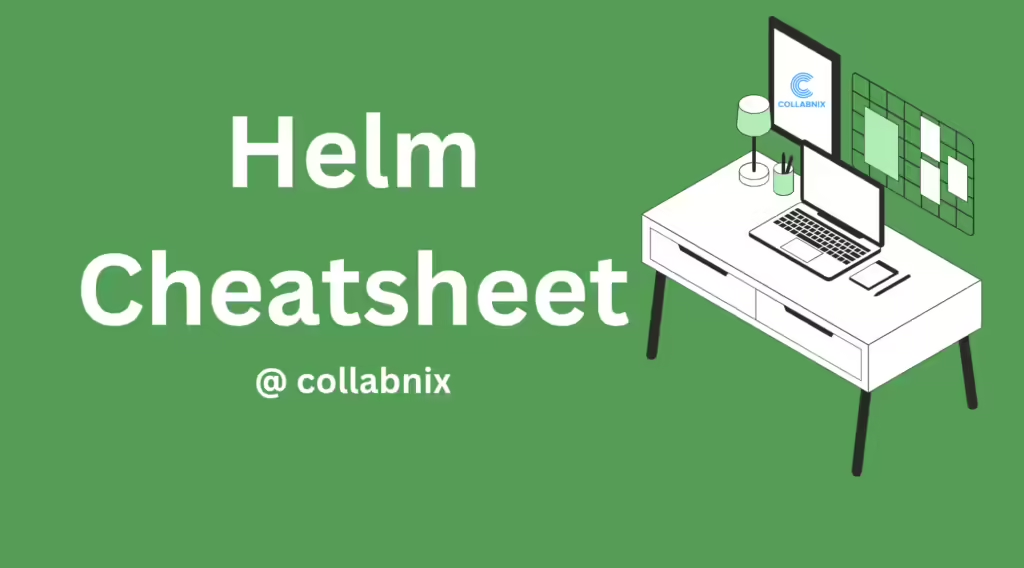
This comprehensive Helm cheatsheet provides all the necessary commands for managing applications using Helm, contextualizing the terminology like Chart, Name, Release, Revision, Repo-name, and DIR. Each section includes the commands along with practical examples and options.
Chart Management
Chart management focuses on creating, validating, and inspecting Helm charts, which act as templates for deploying Kubernetes resources. Use these commands to develop and package your charts or interact with chart repositories.
| Command | Description | Example Snippet |
|---|---|---|
helm create <name> | Creates a chart directory with common files and directories used in a chart. | helm create my-chart |
helm package <chart-path> | Packages a chart into a versioned .tgz archive file. | helm package ./my-chart |
helm lint <chart> | Validates a chart for syntax errors and best practices. | helm lint ./my-chart |
helm show all <chart> | Displays all metadata and configuration for a chart. | helm show all stable/nginx |
helm show values <chart> | Displays the contents of the values.yaml file for a chart. | helm show values stable/nginx |
helm pull <chart> | Downloads a chart from a repository. | helm pull stable/nginx |
helm pull <chart> --untar | Downloads and extracts a chart to a directory. | helm pull stable/nginx --untar=true |
helm dependency list <chart> | Lists dependencies for a chart. | helm dependency list ./my-chart |
Install and Uninstall Applications
These commands are used to deploy applications into a Kubernetes cluster using Helm charts. You can customize deployments with values or simulate installations for testing.
| Command | Description | Example Snippet |
|---|---|---|
helm install <name> <chart> | Installs a chart and names the release. | helm install my-release stable/nginx |
helm install <name> <chart> --namespace <namespace> | Installs a chart in a specific namespace. | helm install my-release stable/nginx --namespace web-app |
helm install <name> <chart> --set key=val | Sets values via the command line during installation. | helm install my-release stable/nginx --set replicaCount=2 |
helm uninstall <name> | Uninstalls a release and deletes resources. | helm uninstall my-release |
Upgrade and Rollback Releases
Use these commands to update an existing release with new configurations or rollback to a previous state in case of issues.
| Command | Description | Example Snippet |
|---|---|---|
helm upgrade <release> <chart> | Upgrades an existing release with a new chart or configuration. | helm upgrade my-release stable/nginx |
helm upgrade <release> <chart> --atomic | Rolls back automatically if the upgrade fails. | helm upgrade my-release stable/nginx --atomic |
helm rollback <release> <revision> | Rolls back a release to a specific revision. | helm rollback my-release 2 |
Repositories Management
Manage Helm repositories to discover, add, update, and remove chart sources.
| Command | Description | Example Snippet |
|---|---|---|
helm repo add <repo-name> <url> | Adds a repository to Helm. | helm repo add stable https://charts.helm.sh/stable |
helm repo list | Lists all added repositories. | helm repo list |
helm repo update | Updates local repository cache. | helm repo update |
helm search repo <keyword> | Searches repositories for charts using a keyword. | helm search repo nginx |
Release Monitoring
These commands allow you to check the status of Helm releases and review their deployment history.
| Command | Description | Example Snippet |
|---|---|---|
helm list | Lists all releases in the current namespace. | helm list |
helm status <release> | Displays the status of a release. | helm status my-release |
helm history <release> | Shows the history of a release, including revisions. | helm history my-release |
Inspecting and Debugging
These commands help you debug issues by providing detailed information about Helm releases and their generated resources.
| Command | Description | Example Snippet |
|---|---|---|
helm get values <release> | Retrieves the values used for a release. | helm get values my-release |
helm get manifest <release> | Displays the Kubernetes manifests generated by a release. | helm get manifest my-release |
helm get hooks <release> | Shows hooks for a release. | helm get hooks my-release |
Plugin Management
Extend Helm’s functionality using plugins for tasks like comparing manifests (helm-diff) or managing secrets (helm-secrets).
| Command | Description | Example Snippet |
|---|---|---|
helm plugin install <url> | Installs a Helm plugin from a URL or local path. | helm plugin install https://github.com/databus23/helm-diff |
helm plugin list | Lists installed Helm plugins. | helm plugin list |
Advanced Options
Commands for environment configuration, template rendering, and debugging workflows.
| Command | Description | Example Snippet |
|---|---|---|
helm env | Prints environment variables used by Helm. | helm env |
helm template <chart> | Renders a chart into Kubernetes manifests without installing. | helm template stable/nginx |
This cheatsheet is a one-stop guide for mastering Helm, helping you effectively manage Kubernetes applications with practical examples for real-world scenarios.